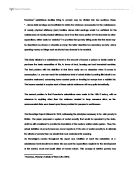Is the United States truly a classless society where there is equal opportunity for all and where everyone has the same chance to succeed?
Janine Popper
December 3, 2010
English 100-ACSS
Dan Lowe
Assignment 5
Is the United States truly a classless society where there is equal opportunity for all and where everyone has the same chance to succeed? Several authors, including Jean Anyon, John Taylor Gatto and Gregory Mantsios, have argued that America does have a class problem and since there are poor and rich classes, people do not have the same opportunity to succeed. I believe that people are born with equal rights under the law but that does not mean that they will have the same opportunity to succeed. I will show how the above authors prove that the United States is a class society that does not give equal opportunity to everyone, particularly in education and the chance to succeed.
Gregory Mantsios wrote a book called Class in America: Myths and Realities. In it he portrays how the United States believes in four myths about the country that many believe in, but ultimately are unfounded. I will discuss two myths: (1) the myth that “the United States is fundamentally a classless society and such basic needs as …education are provided to all regardless of economic standing” and (2) that “everyone has an equal chance to succeed.” (306-307). Mantsios showed that “the contrast between rich and poor is sharp, and with nearly one-third of the American population living at one extreme or the other, it is difficult to argue that we live in a classless society.” (307-308) He cites statistics such as “sixty percent of the American population holds less than 6 percent of the nation’s wealth.” (308) He describes how a well-known economist, Paul Samuelson, explained this to his students. “Samuelson asked them to picture an income pyramid made of children’s blocks, with each layer of blocks representing $1000. If we were to construct Samuelson’s pyramid today, the peak of the pyramid would be much higher than the Eiffel Tower, yet almost all of us would be within six feet of the ground.” This means that a small minority of families earn most of the income while the rest of the income is shared by the majority of middle-income and low-income families. (309)








